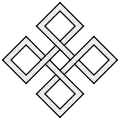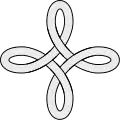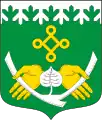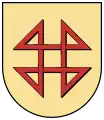| Bowen knot | |
|---|---|
 | |
| Information | |
| Family | Bowen Family |
| Region | Wales |
The Bowen knot (also known as the heraldic knot in symbolism) is not a true knot, but is rather a heraldic knot, sometimes used as a heraldic charge. It is named after the Welshman James Bowen (died 1629)[1] and is also called true lover's knot.[1] It consists of a rope in the form of a continuous loop laid out as an upright square shape with loops at each of the four corners.[2] Since the rope is not actually knotted, it would in topological terms be considered an unknot.
In Norwegian heraldry a Bowen knot is called a valknute (valknut) and the municipal coat of arms of Lødingen from 1984 has a femsløyfet valknute which means a Bowen knot with five loops.[3]
An angular Bowen knot is such a knot with no rounded sides, so that it appears to be made of five squares. A Bowen knot with lozenge-shaped loops is called a bendwise Bowen knot or a Bowen cross.
The Dacre, Hungerford, Lacy, Shakespeare, and Tristram knots are all considered variations of the Bowen knot, and are sometimes blazoned as such.
The Bowen knot resembles the symbol ⌘ (looped square), which is used on Apple Keyboards as the symbol of the Command key. However, the origin of this use is not related to the use of the Bowen knot in heraldic designs.
 Bowen knot in a book from 1827[4]
Bowen knot in a book from 1827[4] Angular Bowen knot
Angular Bowen knot Bowen cross
Bowen cross Arms of the Norwegian municipality Lødingen
Arms of the Norwegian municipality Lødingen.svg.png.webp)
 Totem sign as a symbol of the ancient culture of the region in the coat of arms of Kostomuksha city
Totem sign as a symbol of the ancient culture of the region in the coat of arms of Kostomuksha city Fensterrautenkreuz
Fensterrautenkreuz
References
- 1 2 Francis Jones: Bowen of Pentre Ifan and Llwyngwair, in: The Pembrokeshire historian journal of the Pembrokeshire Local History Society, No. 6 (1979), p. 40, online here on the National Library of Wales website: "James Bowen ... died at Llwyngwair on 22 October 1629 ... The main escutcheon borne on the melancholy occasion showed in the first and fourth quarters, azure a lion rampant or within an orle of roses or, in the second quarter gules a chevron or between three true-love knots or, and in the third quarter, azure a bird standing argent." (emphasis added)
- ↑ Julian Franklyn, John Tanner: An Encyclopaedic Dictionary of Heraldry, Oxford 1970, p. 47: "a grummet laid out square and turned over at the corners forming external loops."
- ↑ Hans Cappelen and Knut Johannessen: Norske kommunevåpen, Oslo 1987, page 197.
- ↑ Hugh Clark, A Short and Easy Introduction to Heraldry, London 1827, Part 2, Table 3 Bordures Counterchangings & Lines, fig. 7
- ↑ "Hausgereut". Heraldry of the World. Retrieved 2013-02-24. Wappenbeschreibung: In Gold das rote Dorfzeichen in Form von vier miteinander verflochtenen Dreiecken.
Sources
- "Lord Kyl's Heraldry – Glossary – Bo... – Entry: Bowen's Knot". Lord Padraig MacKay of Kyle. Archived from the original on 2008-10-15. Retrieved 2013-02-15.
- Heraldic Templates — Knots.
See also: